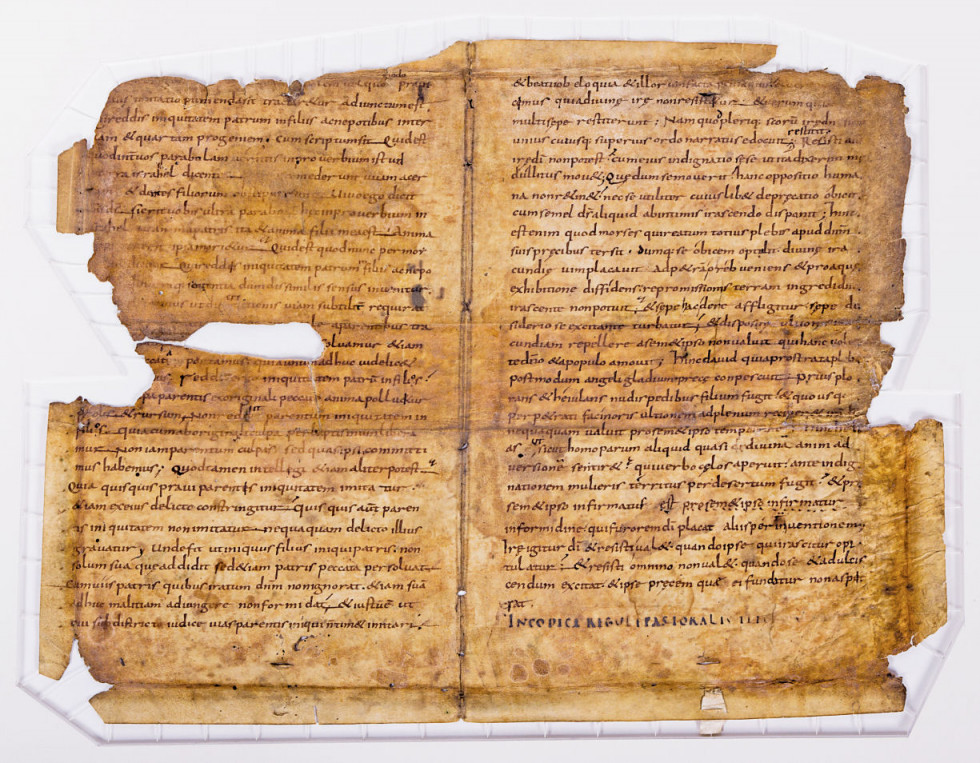-
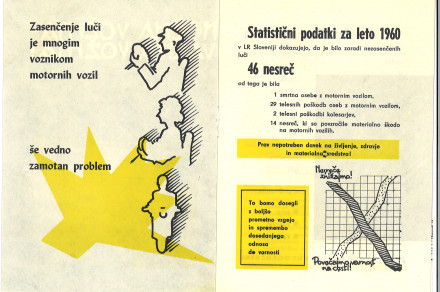
December 2020
»Switching off Full Beam Headlights is still a Complicated Issue for Many Motor Vehicle Drivers«
The beginnings of mass motorization in Slovenia go back to the 1960s and coincide with the construction of new road sections and the planning of the first few kilometres of motorways. As a result, this increase in traffic, along with some other causes, led to an increased number of road traffic fatalities. One of the major issues at that time was the use of high beam headlights, which dazzled drivers in the preceding vehicles and other traffic participants alike. To prevent such behaviour, a campaign was launched, the purpose of which was to put a stop to such dangerous behaviour and to raise awareness among the drivers that they were not alone on the road and that for safety’s reasons they needed to switch off their full beam headlights. The emphasis here was particularly on the night driving.
-
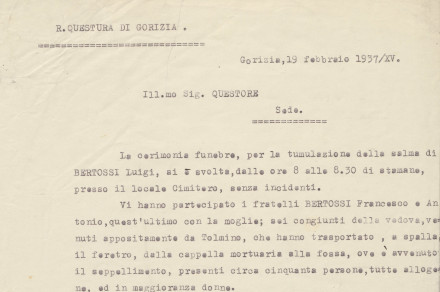
November 2020
They Made Him Drink Black Oil
On December 27, 1936, after the performance of his choir in Podgora, the Gorizia patriot, composer, organist and choir conductor Lojze Bratuž (1902–1937) was forced to drink a mixture of machine oil and petrol by a group of fascists. Less than two months later he was dead. Although the Archives of the Republic of Slovenia does not keep documents about the actual horrific attack, we do keep documents that may shed light on some less known reactions of the Italian local authorities to his death. Namely, the preserved documents reveal the plans of the Gorizia Office of Quaestor to secure Bratuž's funeral, which points to a fact that Italian authorities feared that the funeral may lead to riots. The authorities also supervised Bratuž's grave, because they were afraid that the so-called "cult of Bratuž" might be developing.
-
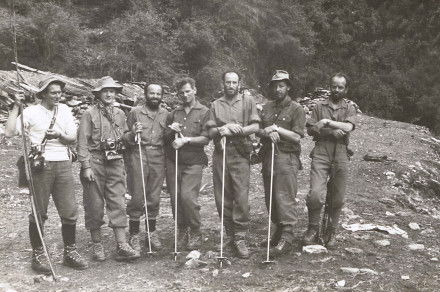
October 2020
From the Life in the Himalayas
The first "Yugoslav" Himalayan expedition (I. JAHO) was the longest Slovenian expedition. It lasted from March to August 1960 because the team travelled to their destination and back by ship. The expedition included seven Slovenian climbers and managed to reach the summits of Baraltoli (5720 m), Trisul II (6690 m) and Trisul III (6270 m). Preserved by the Archives of the Republic of Slovenia, among its records of the Alpine Association of Slovenia, are documents and photos from the expedition. This month's archivalia presents the journey of the expedition and provides a glimpse into the everyday life of the climbers.
-
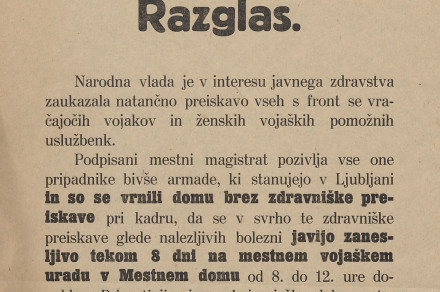
September 2020
»… and they returned home without being medically examined …«
At the end of World War I the world was in the grip of the Spanish flu, which in the Slovenian territory claimed around 6000 lives. The epidemic here was of short duration, perhaps also due to suitable measures taken. To prevent the spreading of the infectious disease, the government of the newly founded State of SHS issued a decree in mid-November 1918, ordering those returning from the front line and those who had already returned but had not been examined yet to undergo obligatory physical examination. The duty of enforcing this state decree was assigned to local authorities. Public proclamation of one such authority, the Ljubljana Town Hall, is preserved by the Archives of the Republic of Slovenia.
-
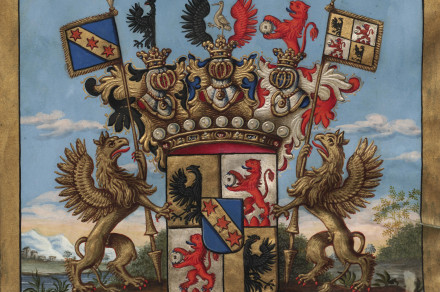
August 2020
Barons Müller-Hörnstein in the Records of the Archives of the Republic of Slovenia
In 2018 the Archives of the Republic of Slovenia purchased a small, but extremely interesting collection of archival material, which is believed to have been preserved at the Vransko Manor. Although the collection includes no more than eight pieces - all of them written on parchment and paper - the records themselves actually span over a longer period of time between 1239 and 1831. The most interesting and most revealing record about the Müller-Hörnstein family is a charter which was written as a proof of ancestry (the so-called Ahnenprobe) in Vienna in 1806.
-
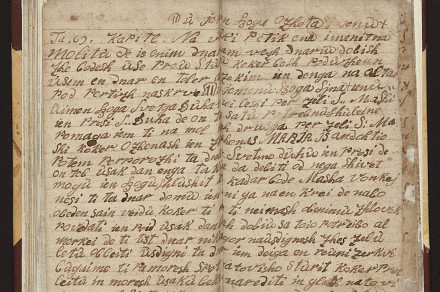
July 2020
Kolemonov žegen - Book of Magic, Charms and Prayers for Protection
Slovenian folk tradition has preserved a number of “efficient ways of protection” against various misfortunes and one such "weapon" was also Kolemonov žegen.The original is believed to have been written in Latin. It spread across the German territory and as a translated version found its way from the present-day Carinthia across the entire territory of today’s Slovenia. It contained a collection of protective prayers, formulas and magic words, superstitions and instructions on how to get the favour of supernatural beings so as to avoid any misfortunes and be successful in acquiring earthy material goods.
-

June 2020
A Poem by Ivan Cankar Dedicated to Alojzija Štebi
Ivan Cankar has up to now been the focus of two articles in our online series Archivalia of the Month; in March 2011 we presented the report on censorship in regard to the staging of Cankar's play Hlapci, and in August 2013 we published the court document, revealing how Cankar's lecture Slovenians and Yugoslavs earned its author a week in prison in 1913. This month's archivalia focuses on one of his muses, to whom the writer wrote an original dedication, although the actual written media on which he chose to write this dedication (a postcard depicting St. James's Church in Ljubljana) seems somewhat less original.
-
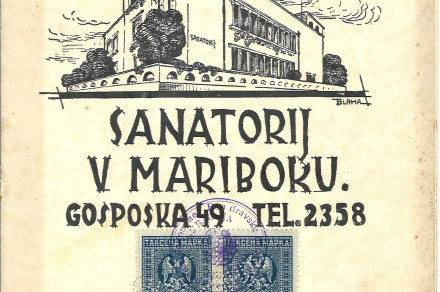
May 2020
Dr. Mirko Černič and the 90th Anniversary of the Opening of the Sanatorium in Maribor
Head physician Dr. Mirko Černič established himself in the world of medicine as a physician, organizer, scientist, professor and a publicist. His greatest achievement, though, was the first purposely built sanatorium in Maribor, whose construction he himself planned and financed. Ninety years have passed since the opening of the sanatorium.
-
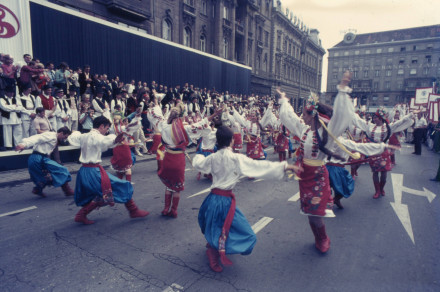
April 2020
Bojan Adamič – Between Photography and Film
Bojan Adamič is one of the most celebrated Slovenian composers of the 20th century popular music. He was also a keen amateur photographer and filmmaker. Preserved at the Archives of the Republic of Slovenia are over 60 of his films; recently Adamič's daughter Alenka donated to us also 1559 of his slides which are very diverse in content. Taking into account the number and excellent quality of the donated slides, we decided to arrange them in a separate archival collection, and some examples of Adamič's photographic creativity are presented here as this month's archivalia.
-
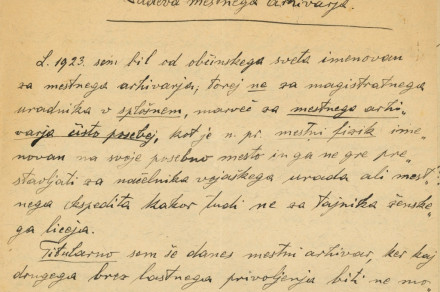
March 2020
The City Archivist Vladislav Fabjančič at Life's Crossroads
The request written by the city archivist Vladislav Fabjančič in September 1935 and addressed to the Ljubljana mayor Vladimir Ravnihar is interesting in two regards. Firstly, it is a story of Fabjančič's work – he himself calls it »a matter of a city archivist«, which far surpasses the faith of any ordinary city clerk. His dealing with issues ever since the start of his employment in 1923, but particularly the complications he needed to face up to after the year 1933, dictate his distinctly personal tone of record, which a reader may find appealing, but still needs to critically review.
-
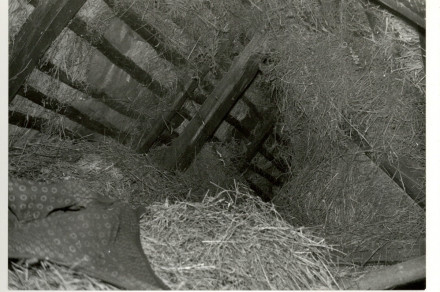
February 2020
»I Was in Hiding for a Very Long Time …«
Defeat is usually difficult to accept. In Europe as well as in Asia many soldiers from the ranks of the defeated armies found it difficult to come to terms with the fact that the war was really over. During the first post-war months and even years there were a number of such individuals, and in some cases even entire military units, fighting their own “private” wars long after the actual hostilities formally ended, either by launching their own guerrilla attacks or just by hiding and refusing to surrender. Well-known example are Japanese officers and soldiers; the last ones among them surrendered themselves in Southeast Asia in 1974. The former member of the Home Guard Janez Rus was in hiding even for a couple of years more.
-
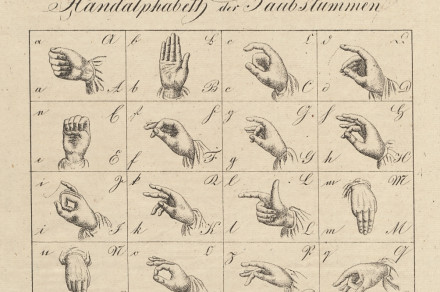
January 2020
First Steps Towards the Education of the Deaf in Carniola and Carinthia
This year marks the 120th anniversary of the opening of the Carniolan Founding Institution for the Deaf in Ljubljana, but care for and education of deaf children can be traced back to as early as the1820s. In September 1829, the first four pupils, two from Carniola and two from Carinthia, were accompanied to Linz and in August the following year the director of the school Michael Bihringer sent a report to the Carniolan authorities, describing the progress the pupils had made in their first year at school.


